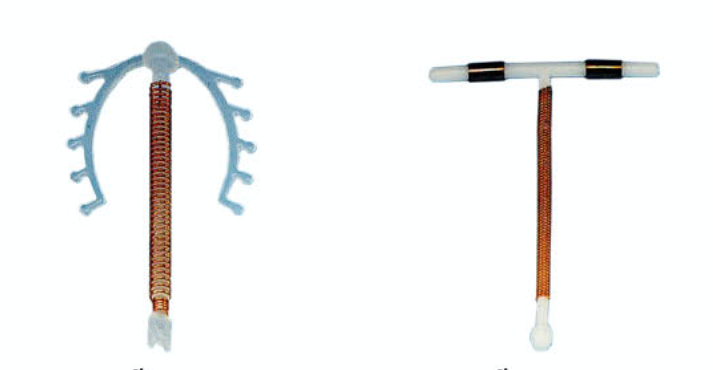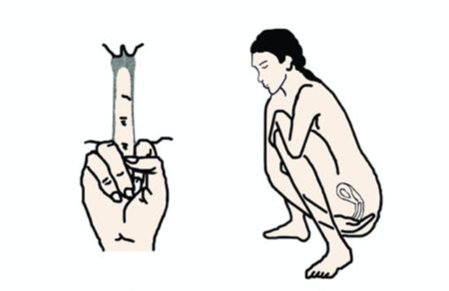The intrauterine device (IUD) is a good temporary contraceptive method and is widely used due to its high effectiveness in preventing pregnancy, cost-effectiveness, and long-term contraceptive capability until one is ready for pregnancy. The IUD can be easily removed, and fertility returns in a short period.
The contraceptive IUD resembles a T-shape or an anchor shape, inserted into the uterine cavity to prevent egg implantation. You can get an IUD inserted at any time (if you are sure you are not pregnant). The best time is within 10 days from the first day of menstruation. It can provide contraception for 5 to 10 years, depending on the type of IUD. After insertion, the doctor will schedule regular check-ups, and you should attend these appointments until it is time to remove the IUD.

Who is the contraceptive IUD suitable for?
- Breastfeeding mothers, as it does not affect milk supply during breastfeeding.
- Those who are contraindicated for hormonal contraceptives, such as smokers, frequent headaches, high blood pressure, etc.
- Those who have problems with other contraceptive methods, such as inconvenience with condoms, frequently forgetting to take birth control pills, or missing contraceptive injections.
- Those who want to space pregnancies and do not want permanent contraception.
Types of contraceptive IUDs can be simply divided into 4 categories
- Hormone-coated (progestin-releasing IUDs): This type of IUD is coated with progestin, which is also a component of birth control pills.
- Unmedicated or inert IUDs: The first type of contraceptive device for women, coated with sulfate for X-ray detection, with indefinite usage duration.
- Frameless IUD: This type of IUD has no plastic frame, only copper cylinders threaded on silk. The advantage is its small size and effectiveness comparable to other types.
- Copper IUDs: The most popular IUD, with a plastic core in various shapes and copper wire wrapped around it. Copper significantly aids in contraception.
The appropriate time for IUD insertion can be divided into 2 periods:
Non-childbirth related period
1. During menstruation or the last days of menstruation is the most suitable time, as there will be bleeding for another 1-2 days after IUD insertion.
2. Within the first 10 days of the menstrual cycle to ensure no pregnancy.
3. If already using another contraceptive method without errors, the IUD can be inserted at any time during the menstrual cycle.
4. If there is no sexual intercourse during that cycle, it can be inserted immediately.
Postpartum or post-abortion insertion
Postpartum IUD insertion: Can be done within the first 48 hours after childbirth or immediately within 10 minutes after placenta delivery. Currently, it is not popular because the IUD can easily dislodge. After this, it should be inserted during 4-6 weeks postpartum, which is easier and has fewer complications.
Post-abortion IUD insertion: Can be done immediately after abortion if there is no inflammation or infection, and 3 weeks after abortion.
Benefits of using an IUD
1. Insert once, long-term protection, as the lifespan of an IUD is on average 5-10 years, making it very cost-effective.
2. Suitable for those who often forget to take birth control pills or need to get contraceptive injections.
3. No side effects like birth control pills, such as nausea, vomiting, weight gain, etc.
4. Does not reduce sexual pleasure.
5. Menstruation remains normal.
6. For those who already have children but want contraception, this method allows for normal breastfeeding.
7. The IUD can be removed immediately when wanting to conceive, without waiting for the effects of birth control pills to wear off, both oral and implant types.
Advice after IUD insertion: You should check the IUD string at home once a month, 2-3 days after menstruation ends. Wash your hands thoroughly and use your dominant hand to insert your middle finger into the vagina to feel for the IUD string at the cervix. If the string is not found, is shorter or longer than usual, or if the IUD is displaced or dislodged, you should promptly see a doctor, abstain from sexual intercourse, or use condoms until a new IUD is inserted.
Some may wonder if the IUD causes pain during intercourse for the male partner: https://rsathai.org/en/contents/25789

Possible side effects
In the first 2-3 days after IUD insertion, there may be lower abdominal pain or cramps, or spotting.
In the first 3-4 months after IUD insertion, there may be abnormal symptoms such as heavier and longer menstruation, lower abdominal pain during menstruation, and increased vaginal discharge. After that, these symptoms will disappear.
Abnormal symptoms that require a doctor’s visit
- Missed periods, irregular or abnormal bleeding.
- Increased lower abdominal pain or pain during intercourse.
- Abnormal color or odor of vaginal discharge.
- Feeling unwell, fever, chills.
Currently, the National Health Security Office (NHSO) supports the cost of contraceptive implants/IUDs for adolescents under 20 years old and all ages after abortion/pregnancy termination without any charges. Information on healthcare facilities providing contraceptive implants and IUDs can be found at: https://rsathai.org/healthservice
Source:
- Reproductive Health Services Manual for Health Personnel
- DKT Thailand
- When Unplanned Pregnancy: Life Has Choices, Contraception to Prevent Unplanned Pregnancy
- Family Planning Unit, Prince of Songkla University
